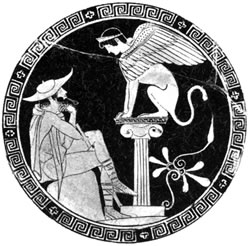Meme 2
Part 2 of a Series
(Wherein the Author Digresses in Plummy Alistair-Cook Tones, Hoping to Clarify a Few Concepts before Applying Them to Cases)
Evil has exactly the same sort of reality as knowledge and consciousness; it exists in that it persists over time and operates in and on the world. But when we would locate it in the world, it’s a mirage. There is something deeply primitive in the operation of evil (and its ubiquitous symbolism); it seems to arise in a sort of pre-classical aspect of consciousness, which is found nowadays among those little inclined or equipped to know themselves as individuals, but formerly among those conditioned to function half-aware within long fixed traditions and institutions. By the evidence of the texts, at least, in ancient times such people were much more inclined to locate endogenous phenomena, such as the whisperings of intuition, and other products of subconscious process, in the external world. Dreams, inspirations, emotions, intuitions, conscience, and delusion were thought produced by gods, muses, harpies, curses or demons. Gradually the collective consciousness raised itself with shared experience, sophistication of language and metaphor, and, as truly modern individual consciousness came about, myths arose depicting a phenomenon, the endogenous/exogenous confusion. Most poignant are Narcissus and Oedipus, but there are many others.
The Oedipus myth is quintessentially germane to the understanding of evil, an almost rococo depiction of the evil’s projected mirage. A brief recapitulation: When Theban King Laius consults the oracle about the children to be born to him and Queen Jocasta he is told, ‘You will have a son and then die at his hands.’ When the son, Oedipus, is born Laius condemns him to death by exposure, but a shepherd rescues him and gives him to the king of Corinth who raises him. Grown, Oedipus consults the oracle and is told to avoid his homeland, for he would murder his father and marry his mother. To avoid this fate, he exiles himself from Corinth and wanders into Thebes, where he kills an arrogant stranger at a crossroads – King Laius. Then he rescues the city by solving the bedeviling Sphinx’s riddle (‘Man is the animal that goes on four, two and three feet.’) Oedipus the hero marries the Queen – his mother. But plague besets the city; the unexpiated murder of Laius is the cause. The vainly clever Oedipus vows to find and banish the culprit. Interrogating witnesses, he does finally sleuth out the perpetrator: himself. Subsequently Jocasta hangs herself in horror: Oedipus stabs his own eyes out (literalizing his metaphorical blindness) and banishes himself as promised.
The Oedipus tale is a recursive variation on two themes: unintended consequences ushered in by preventative measures (the gods’ wickedly ironic joke woven through creation), and the blindness of objective certitude. Oedipus embodies the second theme; he sees the evil in his blighted kingdom, but he can’t see in this the operation of his own guilt. He knows the nature of “man”, but he doesn’t really know who he himself is.
Oedipus is, of course, a myth, a metaphor in psychology; the story’s metaphor is paralleled and its moral more succinctly stated in words attributed to Jesus:
Judge not that ye not be judged. For with that judgment ye judge, ye shall be judged: and with that measure ye mete, it shall be measured to you again.
And thy beholdest thou the mote that is in thy brother’s eye, but considerest not the beam that is in thine own eye?
Or how wilt thou say to thy brother, Let me pull out the mote out of thine eye; and behold, a beam is in thine own eye?
Thou hypocrite, first cast out the beam out of thine own eye; and then shalt thou see clearly to cast out the mote of thy brother’s eye.
In Oedipus and Mathew are the same tropes: the mirror-like (I’m-rubber-you’re-glue) rebounding of moral consequences, and the confusion of endogenous discontent with exogenous affront.
No educated person is particularly surprised by such projections (in others, anyway), but everybody should be aware that they often form the imprimatur of evil, which like the most elusive of subatomic quanta, we know mainly in retrospect, by the path it has described through the world. Western history is replete with, or even largely composed of, atrocities undertaken to exterminate an evil for the greater good: the Holy Wars, the Inquisition, the Hundred Years War, the Witch Hunts, the Genocidal civilizing of the heathens, the Civil War, the War to Make the World Safe for Democracy, Prohibition, the Soviet purges, the Holocaust, the Irish Troubles, the War on Drugs, Vietnam, the Killing Fields – none of these accomplished their putative ends, but they did wantonly loose untold suffering into the world by persecuting the evil du jour. Thus, over and over, evil, the unintended consequence, is promoted by the measures taken against it. Nothing then should be less surprising than evil perpetrated through a war on the Axis of Evil.

0 Comments:
Post a Comment
<< Home